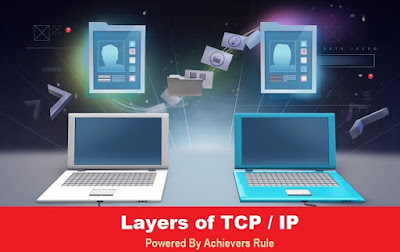 TCP IP Protocol Suit Model and Its Layers
TCP IP Protocol Suit Model and Its Layers

Introduction of TCP/IP Model:
- The TCP/IP Protocol Suite is the combination of two most important protocols i.e. Transmission Control Protocol and Internet Protocol. This protocol suite is the set of the communication protocols which are used for internet and other related networks. The communication software can be divided into layers for labour division, code testing and easy implementation.
Features of the TCP/IP Protocol Suit:
- It was developed prior to the OSI model.
- It provides the ability to transfer the data from one host to another.
- It provides applications with in-order, reliable data stream delivery.
- It is easy to implement.
- Protocols are not hidden in TCP/IP and those cannot be easily replaced.
Layers of TCP/IP Protocol Suit:
Application Layer:
- It is provided by the program which uses TCP/IP for communication purpose.
- An application is the user process which cooperates with another process on different host.
- Application Layer Protocols- Telnet, FTP, SMTP.
Transport Layer-
- It provides end to end transfer of data by delivering it from the application to the remote peer.
- Multiple applications are supported in this layer simultaneously.
- It is comprised of two protocols i.e. TCP and UDP.
- TCP provides the most used, reliable and connection oriented data delivery, congestion control, suppression of duplicate data and flow control.
- On the other hand UDP (User Datagram Protocol) provides connection-less, unreliable service.
Inter-network Layer:
- It is also known as the Internet layer or network layer.
- It provides the “virtual network” image of the internet as it guards the higher levels from the physical network architecture below the Internet layer.
- IP is the most important Internetwork Layer Protocol. It is the connectionless protocol which does not provide flow control, error recovery or flow control.
- The Internet Protocol provides the routing function which attempts to deliver the transmitted messages to the destination.
- The message unit in IP network is called the IP datagram which is the basic unit of information that are transmitted across the TCP/IP networks.
- Internetwork Layer Protocols- IP, ICMP, ARP, IGMP, RARP.
Host-To-Network Layer:
- It is also known as the Network Interface Layer or Data Link Layer.
- It is the interface for the actual network hardware.
- TCP/IP does not support any protocol in this layer.
Similarities between OSI and TCP/IP Model:
- Both of the protocols are based on the stack concept of the independent protocols.
- The functionality of these layers is almost similar.
- The layers above the Transport layer are application oriented for both of the models.
Differences between OSI and TCP/IP Model:
- OSI is the reference model while TCP/ IP is the implementation of the OSI model.
- TCP/IP protocol is considered as the standards around which the internet is developed. But OSI model is the generic, protocol-independent standard.
- TCP/IP merges the presentation and session layer issues into the application layer.
- TCP/IP merges the OSI Data Link and Physical layers into the Host- to-Network layer.
- It is considered as the more realistic model as internet has developed on the basis of this model.
- The design of this model is simple and its efficiency is also good.










Post a Comment